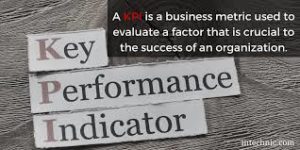
I would say this is the most frequently asked question I receive from our client base. The term goal is pretty well established in the business world. Companies have revenue goals, customer satisfaction goals, productivity goals and the list goes on. More often than not however, there is a void or even a lack of understanding on the part of management as to what exact performance measurements can be used to monitor the success of the initiatives put in place to achieve these goals.
Goals are often too lofty or grandiose for the everyday employee to get their mind around. Everyone knows the company needs to grow in revenue and profit to ensure the future employment and the financial growth of the staff. What they don’t understand is how they directly impact the company’s ability to achieve this. Most employees want to work for a successful organization and will do their part if they clearly understand what their part is. Let’s take a minute and better define the differences between goals and KPI’s.
So as not to overcomplicate the conversation we will start with the basic need of a corporation – revenue growth. A typical goal for an organization might be 10% growth in revenue within the next fiscal year. We have all heard of the term SMART goal. A S.M.A.R.T. goal is defined as one that is specific, measurable, achievable, results-focused, and time- bound. Let’s put our goal to the test.
Specific: a 10% growth in revenue is very specific. It is best to do the math so everyone understands what the 10% means.
Measurable: It is most definitely measurable unless you don’t report out revenue.
Results-Focused: Again very result focused
Time-Bound: Yes it is our desire to achieve this goal within fiscal year 2017.
A Key Performance Indicator is a measurable value that demonstrates how effectively a company is achieving key business objectives. Organizations use KPI’s at multiple levels to evaluate their success at reaching targets. High-level KPIs may focus on the overall performance of the enterprise, while low-level KPIs may focus on processes in departments such as sales, marketing or a call center. For the purposes of simplicity I would like to discuss how this goal will be viewed by three departments – Sales, Customer Service and Production.
The key word at the department level is performance. What are they doing to contribute to the company achieving this goal? Most times these are called initiatives at the department level. How will these departments change their daily activities to achieve a higher level of performance? The sales department is probably most accustomed to this discussion due to the fact that their world revolves around numbers – more leads – more meetings, more meetings – more presentations, more presentations – more proposals, and the more proposals the more revenue booked. Simple, right? Your vice president of sales will more than likely know off hand what these ratio’s look like.
Typical Sales Funnel

The sales department therefore has already established the KPI’s that will help them monitor the success of their team in meeting the goal. The marketing department might be responsible for generating the 100 leads needed (i.e. Marketing Goal).

The sales department’s goal for booked revenue will differ from that of the company in that booked orders don’t invoice until they can be shipped. Obviously this is where customer service and production come in. If these two departments don’t meet their KPI’s the goal for the company will be missed. Production cannot produce the product until the order is processed and the company cannot book the revenue until the order is shipped. The KPI’s will measure the success of the initiatives undertaken to achieve the increase in revenue. If any of these departmental KPI’s fall below the expectation for the initiative implemented immediate action can be taken. This allows the department leaders to tweak the program along the way to ensure its overall success.
The sales department is in most cases a little more straight forward than the other two departments we have selected. However, every department should know what they must do to achieve the overall goal of the organization.
Customer Service has to take the call and process the order in coordination with the sales team. If there is a delay in the processing time the revenue for the month or quarter will be missed. The KPI’s of the customer service group might revolve around processing time or number of calls handled per day. But the goal of the department is to process the number of orders booked by the sales group within a specific period of time that will allow production the time they need to produce and ship the product needed to meet the revenue goal for the company.

In the same way the production department will need to set their goal to be in line with what the customer service department can process. In some cases they might over produce if there is a high confidence level on the part of the sales VP. See if you can draw out a KPI chart for the production department. If not send me and e-mail (pat@tecresourcecenter.com) and I will work through it with you for your company.
Successfully run companies know that engaged employees who understand how they directly contribute to the goals of the organization will lead to the improved implementation of the strategic initiatives and faster growth year to year. Does your team understand the KPI’s for your organization? Is there a reporting process to monitor the success of your strategic initiatives? I will discuss balanced score cards and KPI dashboards in upcoming blogs. Sign up for our monthly TEC Talk update ( https://tecresourcecenter.com/contact-us ) to ensure you receive future discussions.
